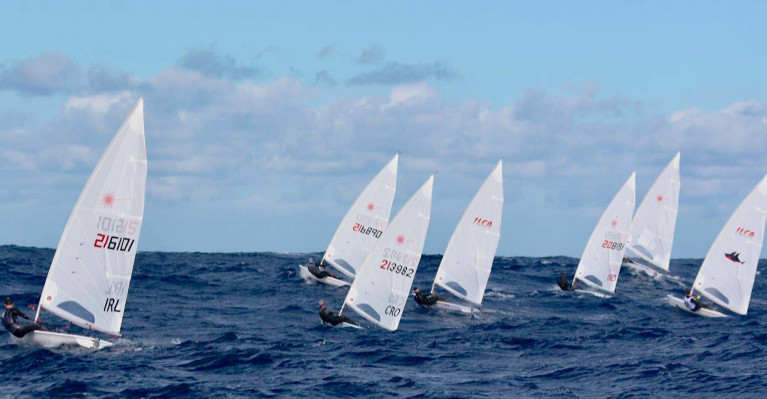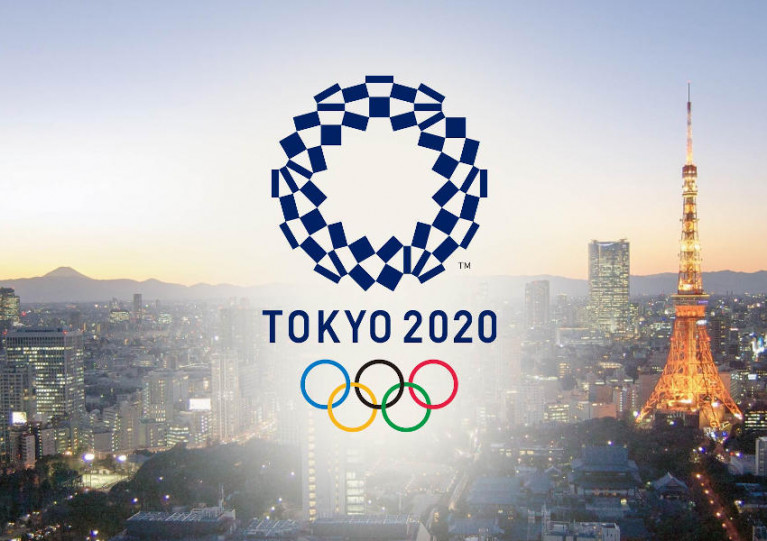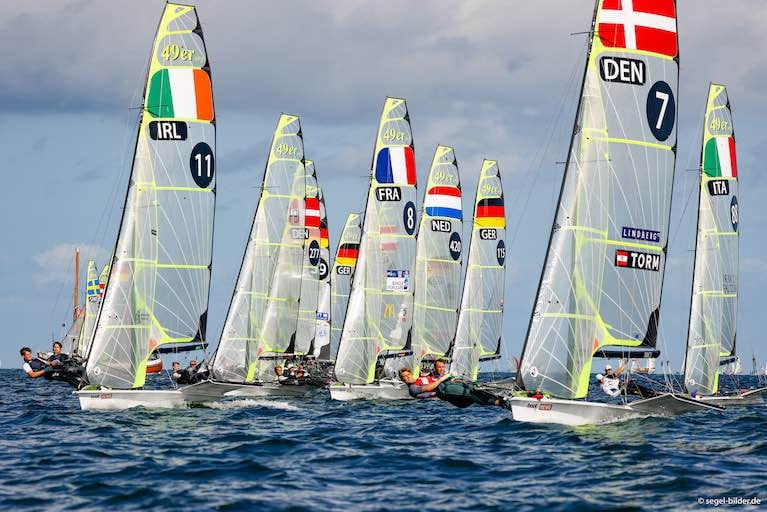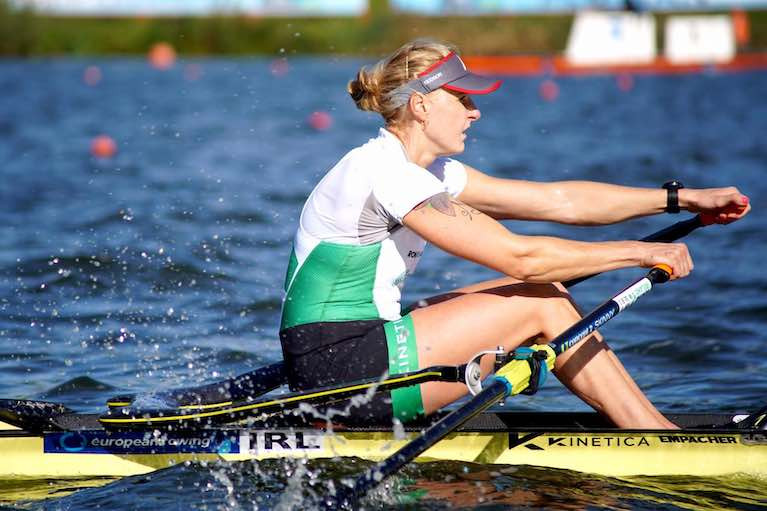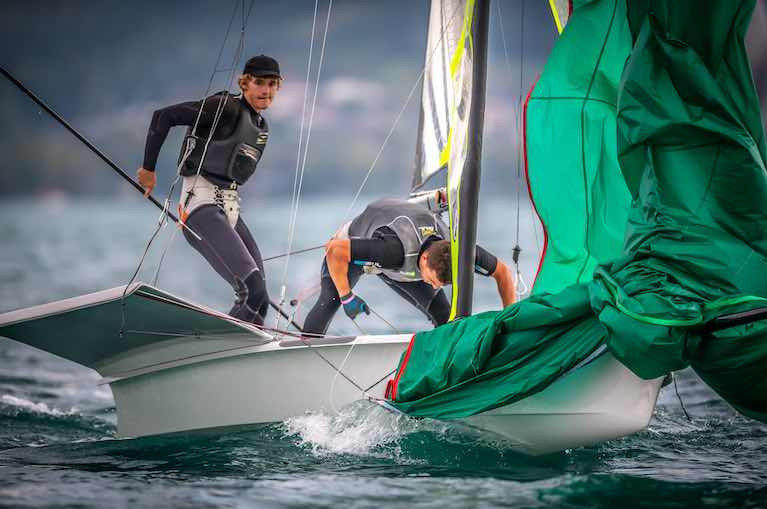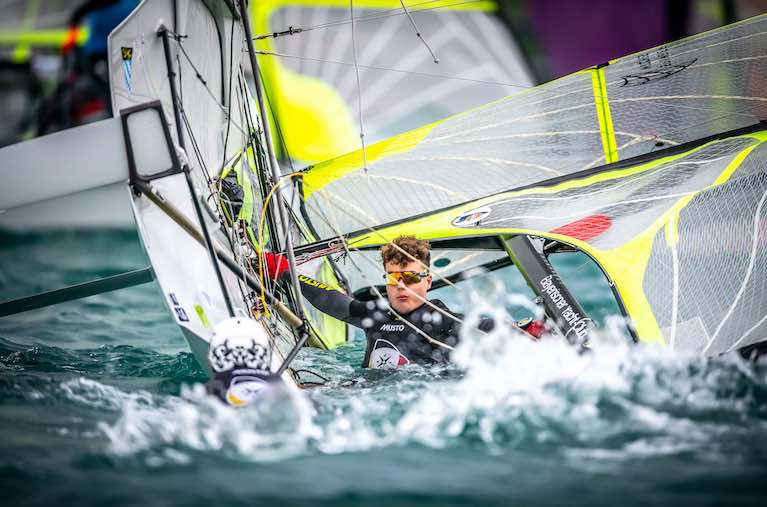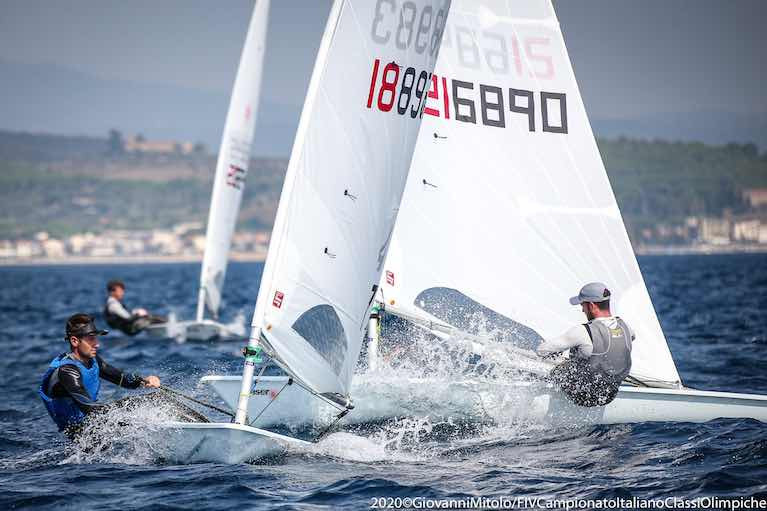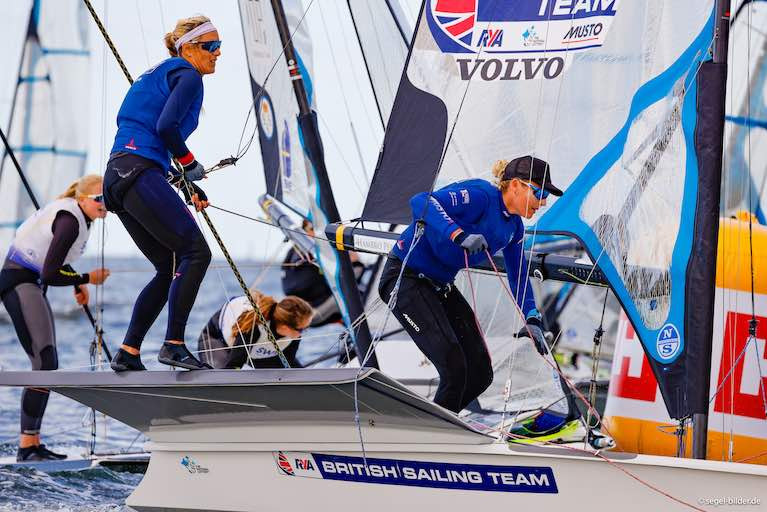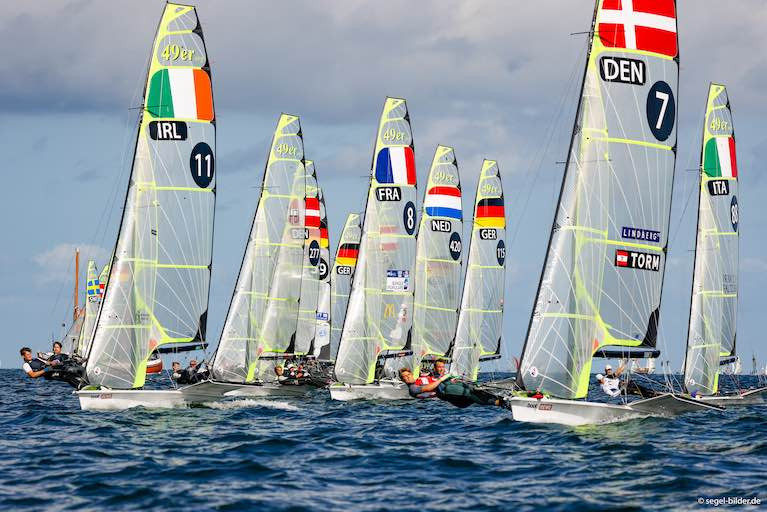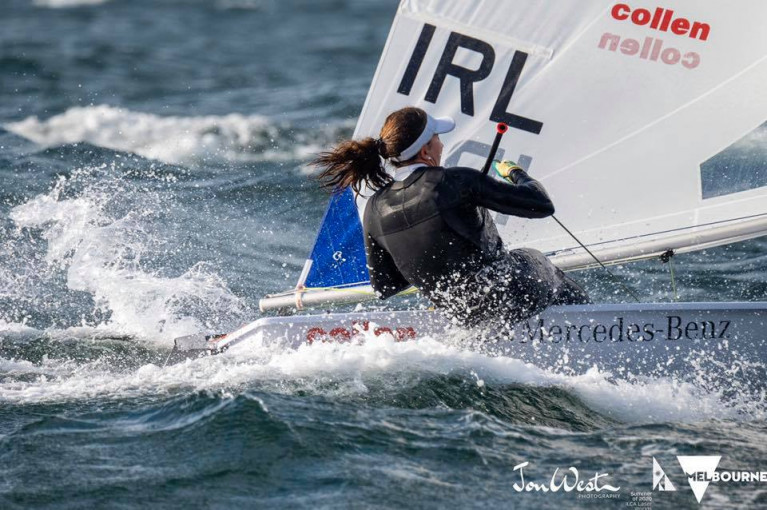Displaying items by tag: Tokyo 2020
Irish Laser & 49er Sailors Continue to Train for Tokyo 2021 as Olympics Cancellation Report is Denied
The Olympic Federation of Ireland (OFI) continue to plan for a “very different type” of Olympic and Paralympic Games experience in Tokyo this summer.
The OFI released a statement on Friday night after hosts Japan and the International Olympic Committee earlier stood firm on their commitment to host the Tokyo Olympics this year and denied a report of a possible cancellation.
From an Irish Olympic sailing point of view, the planning for the Tokyo Olympic Regatta this July therefore also continues.
Ireland's Annalise Murphy is the only Tokyo qualified sailor at this point. The Rio silver medalist gave an update on training in lockdown to the Irish Laser class agm late last year as Afloat reported here.
Despite four year campaigns under their belts, both the Irish men's Laser and 49er crews are rueing earlier missed chances to qualify in their respective classes.
As a result, two Irish Olympic dinghy berths in Tokyo hang on last-minute bids to secure berths at European qualifiers this Spring.
European Qualification for Irish Laser and 49er?
As Afloat previously reported, four nations are in contention for just one 49er place, including Ireland. In the Laser, two places are available with a 'bunch of five or six nations' including Ireland chasing them.
Adding more doubt to qualification, however, are questions now also being expressed about whether these last qualifiers can be held. The venues are scheduled for Palma, Mallorca for the 49ers and Hyeres, France for the Lasers at the same time as stronger lockdowns emerge in both countries.
As Afloat reported recently, the Irish Laser men were training in Malta this January. They plan to go on to Lanzarote in the Canaries at the end of the month for more competition, and then there’s a further diversion for a challenge on Croatia in the buildup to the final Olympic qualifier in Hyeres in April.
Historical results
World Sailing says the sport aims to complete its outstanding qualification events for Africa, Asia and Europe before the Tokyo 2020 Olympic Games in 2021 but if that proves unworkable the world body also said it would allocate the remaining 15% of quota places using 'historical results' as Afloat previously reported here.
Statement from the Olympic Federation of Ireland
RECENT COMMENTS IN THE MEDIA ABOUT TOKYO
Friday 22 January 2021: The IOC and Tokyo 2020 Organising Committee has made a very strong and clear statement that they are fully committed to the successful delivery of the Olympic and Paralympic Games in Tokyo this year.
Overnight media reports claimed incorrectly that a private decision had been made by the Government of Japan to cancel the Olympic Games.
The Japanese Government has stated categorically that this is not true.
The Olympic Federation of Ireland has also been very clear on this subject in recent weeks. We remain fully of the view, based on regular updates from the Tokyo organisers, that the Games will go ahead in July this year. We do feel that the Games will be very different, with stringent countermeasures in place to safeguard athletes.
Our focus remains on ensuring that our athletes are prepared and ready for this different type of games experience, accounting for the numerous Covid-19 countermeasures, along with vaccination programme.
Our intention is to circulate the most accurate and up to date news as it comes to us and to detail how that impacts the preparations of Team Ireland’s athletes and support staff. To this end we will be scheduling further briefings in our series of Tokyo Ready updates for the media in coming weeks.
In addition, the IOC will be holding a briefing for members of the media on 27 January.
Tokyo Olympics Doubtful, Says Man Who Ran London 2012
The head of the organising committee for the London Olympics in 2012 has said the Tokyo Games scheduled for this summer look “unlikely” to go ahead.
As the Guardian reports, Sir Keith Mills told the BBC he “would be making plans for cancellation” if he were in charge of this year’s Olympics, postponed from 2020 over the coronavirus pandemic that has shown little sign of dissipating as a slow vaccine rollout begins.
Japan is currently under a state of emergency prompted by a surge in Covid-19 cases, just six months before thousands of athletes are set to converge for the Olympiad.
A significant number of competitors have yet to qualify for Tokyo 2020, including the likes of Irish Laser sailor Ewan McMahon, Rio rep Finn Lynch as well as Liam Glynn all vying for one fo the last Tokyo berths along with Ireland’s two 49er campaign duos.
Despite the present situation, World Athletics president Sebastian Coe said he was confident the Games will go ahead “but they will look different”.
Last week a spokesperson for the Tokyo organising committee insisted there had been no discussion about a cancellation or extended delay.
The committee’s head Yoshiro Mori said postponing the Games a second time would be “absolutely impossible”.
The Guardian has more on the story HERE.
As Irish 49ers Eye Last Chance for Tokyo, 2021 49er Europeans are Confirmed for Greece
As Ireland's two 49er campaigns prepare for their last chance to win an Olympic berth in Tokyo, details of the final major championship of the 2020 Quadrennial have been announced in Greece.
After four years of campaigning, minds have been focussed in the Irish camp with the news that the 49er’s Tokyo Olympic qualifier has been confirmed as the Princesa Sofia regatta in Palma, Spain – 26 March – 3 April 2021.
As Afloat previously reported, there are four nations in contention for just one skiff place, including Ireland.
Two Irish boats are up against Sweden, Italy and Belgium. Ryan Seaton and Seafra Guilfoyle and Robert Dickson and Sean Waddilove both chasing the elusive Olympic place.
The teams are currently training at the Irish winter base in Villamoura, Portugal with the Princesa Sofia crunch regatta just 70 days away.
If either of the Irish boats is successful in Palma, there is no doubt they will be heading to Thessaloniki, Greece from May 4-9, 2021 for the 49er, European Championships. Just two months ahead of the Tokyo Olympics, it is expected to be the final chance for Olympians to get into racing form and for the next generation of aspiring Olympians to catch the favourites before they head onto the World Stage.
The regatta will be hosted by the Nautical Club of Thessaloniki is the oldest Nautical club in all of Greece, a country rich a rich history at sea. The club has sent members to the Olympics as long ago as 1948 and more recently has been a centre of 470 and Tornado sailing in Greece. In hosting the 49er, 49erFX, and Nacra 17 European Championship, NCTH will continue this Olympic spirit in the modern double-handed classes.
It is expected that most Olympic contenders will attend, while the Organising Authority understands the need to be careful in bringing people together and of the many travel restrictions in place globally. Onshore activities will be limited and done electronically for the most part, while on water racing activities will simulate the regular racing environment as much as possible.
Path to Paris 2024 Regatta
2021 initiates the Path to Paris, and many new and younger teams are expected to join the racing aiming toward the 2024 Olympics. Four years out from the Olympics is typically when many sailing campaigns get started, and 2021 should be no different.
Rowing Ireland Qualifies Record Number of Boats for Tokyo Olympics
In an update from the Olympic Federation of Ireland, Rowing has qualified a record number of boats for the 2021 Olympics, with four boats heading to Tokyo, and still a good chance to get one or two more in the final qualification regatta before the Games.
The boats are:
Women’s Single Scull – Sanita Puspure finished first in the World Championships 2019
Men’s Lightweight Double Scull – Paul O’Donovan and Fintan McCarthy finished first in the World
Championships 2019
Men’s Double Scull – Philip Doyle and Ronan Byrne finished second in the World Championships 2019
Women’s Pair – Aileen Crowley and Monika Dukarska finished eleventh in the World Championships 2019
Rowing Ireland are still targeting two boats in the European qualifying regatta next year:
Women’s Four (W4-) there are two spots available.
Women’s Lightweight Double (LW2X) there are two spots available
Howth's Dickson & Waddilove in 18th are Top Irish 49er at Europeans on Lake Attersee
In the hunt for the last Olympic berth for Toyko next year, the Irish under-23 duo of Robert Dickson and Sean Waddilove have, for a second time in a fortnight, beaten double Olympian Ryan Seaton sailing with Seafra Guilfoyle at an international regatta.
In their first Olympic campaign, the Howth and Skerries duo finished 18th overall at the European Championships on Lake Attersee in Austria this afternoon leaving the Belfast and Cork combination of Seaton and Guilfoyle ten places behind in 26th overall in the 55-boat fleet.
At Kiel Week Regatta in northern Germany, on September 15th, the Dublin pairing finished 14th, some 13 places ahead of Seaton and Guilfoyle who had a silver fleet finish in 27th place in the 52-boat fleet.
 Seafra Guilfoyle (left) and Ryan Seaton finished 26th at the Lake Attersee 49er Europeans. Photo: Tobias Stoerkle
Seafra Guilfoyle (left) and Ryan Seaton finished 26th at the Lake Attersee 49er Europeans. Photo: Tobias Stoerkle
It's a satisfying result for the former U23 49er world champions as they seek Olympic qualification early next season but it is tempered by the fact that the other three nations chasing the final Tokyo place all finished ahead of them. Italy finished seventh, Belgium eighth and Sweden 17th and that is an urgent reminder to the Irish teams of the work that lies ahead if Ireland is to be on the Tokyo startline next July.
A third Irish team competing, Sean Donnelly and Marcus O'Leary of Dun Laoghaire, placed 48th.
Fischer and Graf cling on to win 49er European Title
Tim Fischer and Fabian Graf have become European Champions in the 49er, despite a wobbly finish to their regatta. A bit like their German counterparts in the 49erFX, Fischer and Graf clocked up two useful scores earlier in the day with 3,2 but then faded in the final two heats with 13,11.
 The Lake Attersee fleet line up for a 49er Euros start Photo: Tobias Stoerkle
The Lake Attersee fleet line up for a 49er Euros start Photo: Tobias Stoerkle
In the final race, it looked like the recovery of the regatta was about to crowned with the best possible finish for local heroes Benjamin Bildstein and David Hussl. On day one, Hussl had been so ill that the Austrian team’s coach stepped in at the front with Bildstein. They were sitting outside of the top 10 with a mountain to climb if they were to have a chance of getting on to the podium. With Hussl recovered and the team back together, they started to put together a solid set of scores.
At the final bear away of the regatta, the Austrians rounded next to an Irish team in 4th place. The simultaneous gybe-set would have gone fine except the Irish trawled the gennaker. In trying to avoid their suddenly-stopped rivals the Austrians capsized! They slipped six places to 10th. The losing margin to the Germans was just 3 points. If only Bildstein and Hussl had avoided the Irish - but that’s yacht racing at the highest level. A game of small margins.
For the Croatian brothers, Šime and Mihovil Fantela, it was also a case of what might have been when they discovered that their race win in the first heat of the morning was a U-Flag disqualification for breaking the start line just a fraction early. The 2018 World Champions had to be satisfied with a bronze medal in Lake Attersee. A race win in the final heat lifted Jonas Warrer and Jakob Precht of Denmark to fourth overall.
Results here
Fortunes Improve for Irish 49ers at European Championships
Fortunes have improved for two Irish 49ers after six qualifying races of the 49er European Championships in Austria. After a shaky start, double Belfast Olympian Ryan Seaton sailing with Seafra Guilfoyle, are now one place (and five points) behind Dubliners Robert Dickson and Sean Waddilove in 16th overall. A third Irish entry in the 55-boat fleet on Lake Attersee is Sean Donnelly and Marcus O'Leary from the Royal St. George Yacht Club who are in fiftieth position.
Šime and Mihovil Fantela scored a 3,1,1 from their qualifying group, moving the Croatians slightly further ahead in the overall standings. The 2018 World Champions are 3 points ahead of the fast-improving Dutch crew, Bart Lambriex and Pim van Vugt, who took 1,3,2, from their side of qualifying. The Dutch team, recently selected for Tokyo 2021, were vigorous in claiming early rights on the pin end of the start line and defending that place with pinpoint precision slow-speed boat handling. In third overall are the Italians Uberti Crivelli Visconti and Leonardo Chistè.
It was good to see David Hussl recovered sufficiently from recent illness to be back in the 49er with his helmsman Benjamin Bildstein and the Austrian team improved throughout the day to move to 11th overall. Two places further back are the Danish duo who won Kiel Week last month, Jonas Warrer and Jakob Precht. Unlike fellow Kiel winners Lutz and Beucke, the Danes seem to be struggling to adapt their winning ways to this very different kind of challenge, lake sailing in light and fluky winds.
Results are here
Irish Laser Sailors Lynch & McMahon Make Top Ten of Italian Olympic Week Despite Early Exit
Two of Ireland's three Olympic men's Laser campaigners finished in the top ten of the Italian Olympic Week fleet today even though they didn't manage to sail the final race in Follonica.
Howth's Ewan McMahon closed the gap on the National Yacht Club's Finn Lynch when he moved up from 12th to finish tenth overall, just three places behind the 2016 Rio rep. Ballyholme's Liam Glynn finished 21st in the 88-boat fleet.
It all adds up to an exciting Irish contest where the prize will be a place at the Tokyo Olympics if a nation berth can be won by any of the three.
As Afloat reported last November, before any Irish Olympic nomination can be conferred at least one of the three must win one of two final European Olympic slots remaining but that Olympic qualifying regatta will not now be held until 2021.
Racing was cut short for the Irish trio in Italy today as they ditched the last race of the series this afternoon in order to catch a flight home before Italy closed to Ireland as a 'green listed' country in the latest round of COVID travel restrictions.
Both American Charlie Buckingham and Brazilian Robert Scheidt managed to overhaul overnight leader Guatemalan Juan Ignacio Maegli for the overall win, according to provisional results issued.
Download results below
The next event for the Irish Laser men is the Europeans in Poland, Gdynia, 6th to 12th of October.
Royal Irish's Saskia Tidey Wins Bronze in Kiel
Dun Laoghaire Harbour skiff sailor Saskia Tidey of the Royal Irish Yacht Club was part of a four medal haul for Britain's Olympic Team GB at Kiel in Germany last weekend.
The British Sailing Team returned an impressive four medals from the popular Kiel Week sailing regatta taking two silver and two bronze.
Charlotte Dobson and Tidey took bronze 49erFX bronze as part of their build-up to Tokyo 2021.
Tidey sailed for Ireland at Rio in the 49erFX but four years later has been selected for Team GB in the same class and is viewed as a medal prospect.
As the return to international racing continues for the British sailors, Team GB athletes John Gimson and Anna Burnet took silver in the Nacra 17, Elliot Hanson claimed silver in the ILCA7.
Hanson was joined on the ILCA7 (formerly Laser Standard) podium by team-mate and training partner Michael Beckett who took bronze.
Howth Yacht Club's Dickson & Waddilove Lead Irish 49er Hopes at Kiel Week in Germany
Two Irish Tokyo rivals both now in the hunt for one of the final European Olympic berths have resumed their battle after COVID at a scaled-down Kiel Week Regatta 2020, in northern Germany this week.
With two races left to sail its Howth and Skerries duo Robert Dickson and Sean Waddilove that lead Irish hopes in 15th in the 52-boat fleet with two final races left to sail today. The pair, who also recorded the top Irish result at the 2020 World Championships in Australia in February, are in the top 30% of the fleet and as such it makes a welcome return to the race track, except for a UFD penalty in yesterday's final race of the day.
The Belfast and Cork combination of double Olympian Ryan Seaton and Seafra Guilfoyle will have probably been looking for more out of the week on the Baltic than their current 32nd position in the international fleet.
Both the 49er teams will head to Austria for the 49er European Championships, from 28 Sept – 4 October on Lake Attersee, a notoriously tricky venue.
As Afloat reported previously Irish campaigns chasing last places in the 49er, Laser and Finn classes were in turmoil in Spring when COVID-19 hit key final European qualifications in Italy and Spain, ultimately postponing the Games itself.
Ireland is competing with Belgium, Sweden and Italy for the one remaining European place. Form at the 2020 Worlds suggests that Irish sailors would be favourites for the place having finished ahead of the other three candidates but the final selection system has yet to be confirmed.
Annalise Murphy's Campaign for Tokyo Olympic Gold Resumes at Kiel Week 2020
Annalise Murphy, Ireland's only qualified sailor for Tokyo 2021, is entered for this week's Kiel Week. The massive German Regatta marks her return to international competition since the outbreak of COVID.
Regular Afloat readers will know that the Olympic programme was thrown into disarray in March when important European Olympic qualifiers were cancelled during the Pandemic.
Now, with the resumption of competition, it is more than clear there is pent up demand with both the quantity and quality of fleets signed up to race on the Baltic Sea.
This is more than evident in Murphy's red hot Laser Radial fleet gathering in Kiel.
The complete top ten of the World Championships 2020 (where Murphy finished 12th) in the Olympic one-handed class for women is on the starting line. Also the three medal winners from Rio Olympics.
Foremost the Olympic champion of 2016 and reigning world champion Marit Bouwmeester from the Netherlands. As at the World Championships in Australia earlier this year, Bouwmeester will meet her compatriot and World Championship runner-up Maxime Jonker, the Norwegian Line Flem Höst, and Anne-Marie Rindom from Denmark. The Dane won the Kieler Woche in 2018 and won the bronze medal ahead of Brazil at the Olympic Games.
Also, last year's winner of Kieler Woche and Olympic and World Championship 6th, Josefin Olsson from Sweden, is certainly among the candidates for the Kieler Woche victory.
As well as Ireland's 2016 silver medalist, the Olympic fifth-placed from Finland Tuula Tenkanen completes the field of favourites.
After Kiel, Murphy will travel to Gdansk, Poland for more training and preparation before the European Championships starting on 6 October.


























